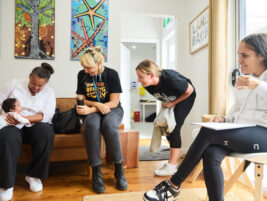New evidence suggests that crying is indeed what triggers some parents to shake their babies. Equipping them with coping strategies may help reduce the incidence of Shaken Baby Syndrome.
Shaken Baby Syndrome (SBS) is a form of intentional injury to infants and children inflicted by violent shaking, with or without impact on a hard surface. It can result in severe head trauma, such as bleeding in and around the brain, retinal hemorrhages and bone fractures. About 25% of clinically diagnosed infants die, and about 80% of survivors suffer lifelong neurological damage.
Excessive crying is often cited as the trigger that causes exhausted or frustrated parents to shake their babies, yet there are limited data backing this claim. Researchers therefore decided to compare the age and incidence of babies hospitalized in California for SBS with the “normal crying curve.” This curve charts the pattern of crying demonstrated by babies in the first few months of life.
The results revealed a number of common properties between the two curves. They both begin their ascent when the infants are two to three weeks of age, following a peak; there is an almost linear decline until about 36 weeks of age. The main difference is the timing of the peak: the number of SBS cases peaks at about 10 to13 weeks, while the crying curve peaks at five to six weeks.
However, given that 35% to 50% of diagnosed shaken baby cases have evidence of prior shaking or abuse, this could simply be a delay between cause and effect. “The shaking episode that brings the child to the emergency room may only be the last in a series of shaking episodes that began days to weeks earlier,” explains lead author Dr. Ronald G. Barr, from the University of British Columbia.
If crying is the trigger for shaking and other forms of abuse, then prevention programs should focus on improving parents’ understanding of the unique properties of early crying. There is increasing evidence that prolonged unsoothable bouts of crying are likely to occur regardless of the soothing methods used. In 95% of cases, this kind of crying is a normal part of a healthy baby’s development. Caregivers who are aware of these facts might get less frustrated, knowing that it will pass.
To this end, the National Center on Shaken Baby Syndrome has developed intervention materials called The Period of PURPLE Crying: P for crying peak; U for unexpected; Rfor resistance to soothing; P for pain-like face (even when the infant is not in pain); L for long crying bouts; and E for evening clustering of crying. Parents are encouraged to take three actions to prevent SBS: First, increase their contact, carry, walk and talk responses, which will help reduce crying, although not stop it altogether. Secondly, if the crying becomes too frustrating, put the baby in the crib and walk away for a few minutes to calm themselves. Finally, never shake or hurt their baby.
Given the similar properties of the age-specific incidence curve for SBS and the normal crying curve, it is hoped that this kind of education strategy will help parents better understand and cope with excessive infant crying, preventing Shaken Baby Syndrome.
References
Tremblay, R.E., Barr, R.G., & Peters, R. DeV, eds. Encyclopedia on Early Childhood Development – Crying Behaviours [online]. Montreal, Quebec: Centre of Excellence for Early Childhood Development. Available at: https://www.excellence-jeunesenfants.ca/theme.asp?id=15&lang=EN
Barr, R.G. (2006). Crying behaviour and its importance for psychosocial development in children. 1-10.
St James-Robert, I. (2006). Effective services for managing infant crying disorders and their impact on the social and emotional development of young children. 1-6.
Barr, R.G., Trent, R.B., & Cross J. (2006). Age-related incidence curve of hospitalized Shaken Baby Syndrome cases: Convergent evidence for crying as a trigger to shaking. Child Abuse & Neglect; 30:7-16.
National Center on Shaken Baby Syndrome (www.dontshake.org)
Preventing Shaken Baby Syndrome
Authors
Krakow, Eve
Canada








